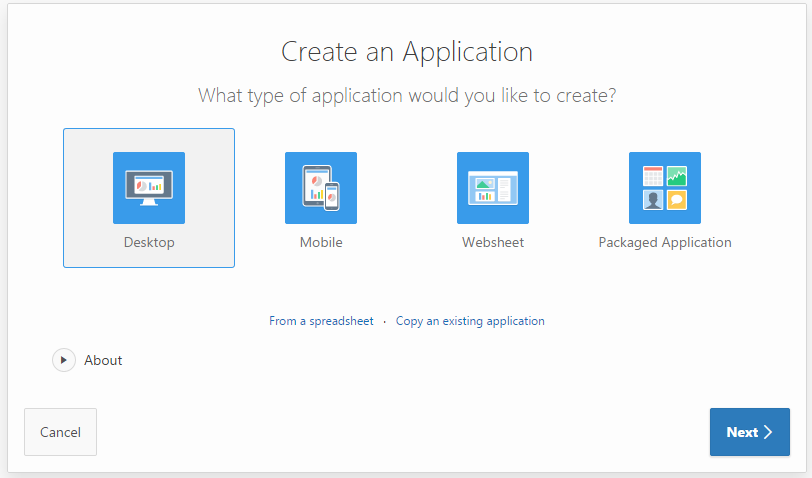2.1 Understanding Oracle Application Express Applications
This section describes what an Oracle Application Express application is, explains the difference between database and Websheet applications, and how to run the Create Application Wizard.
Topics:
- What is an Oracle Application Express Application?
- What Is an Application Page?
- What is the Difference Between a Database and Websheet Application?
- About Running the Create Application Wizard
See Also:
2.1.1 What is an Oracle Application Express Application?
An application is an HTML interface that exists on top of database objects such as tables or procedures. You create both database applications and Websheet applications using the Create Application Wizard. The main difference between these two types of applications is the intended audience. While database applications are primarily developed by application developers, Websheet applications are often created by end users with no development experience.
2.1.2 What Is an Application Page?
A page is the basic building block of an application. Every application consists of one or multiple pages. Each page can have buttons and fields (called items) which are grouped into containers called regions. Pages can include application logic (or processes). You can branch from one page to the next using conditional navigation; perform calculations (called computations); perform validations (such as edit checks); and display reports, calendars, and charts. You view and edit a page in Page Designer.
See Also:
2.1.3 What is the Difference Between a Database and Websheet Application?
An Oracle Application Express application enables developers to manage and display data from an Oracle database. You build an application using App Builder. Using App Builder you can create two different types of applications: Database applications and Websheet applications. This section describes the differences between these application types.
2.1.3.1 About Database Applications
A database application is a collection of pages linked together using navigation menus, tabs, buttons, or hypertext links. Application pages share a common session state and authentication.
To create a database application, an application developer runs wizards to declaratively assemble pages and navigation. Individual pages are organized using containers called regions. Regions can contain text, custom PL/SQL, reports, charts, maps, calendars, web service content, or forms. Forms are made up of fields (called items) which can be selected from the multitude of built-in types (such as text fields, text areas, radio groups, select lists, check boxes, date pickers, and popup list of values).
Developers can also create their own custom item types using plug-ins. Session state (or application context) is transparently managed and the user interface presentation is separated from the application logic enabling developers to manage the look and feel of an application by simply selecting a different theme.
See Also:
2.1.3.2 About Websheet Applications
By creating Websheet applications, end users can manage structured and unstructured data without developer assistance. Page sections contain unstructured data which can be edited using a WYSIWYG editor. Data Grids enable users to manage structured data without the need for writing SQL. Using runtime dialog boxes, users can add columns, rename columns, and validations. Each page and row of data grid data can be annotated with files, tags, notes, and links. Pages can contain sections, reports, and data grids and everything can be linked together using navigation. All information is searchable and completely controlled by the end-user.
See Also:
2.1.4 About Running the Create Application Wizard
To create an Oracle Application Express application, a developer runs the Create Application Wizard. To run the Create Application Wizard, click the Create button on the App Builder home page.
Tip:
The first time you access the App Builder home page, grey box labeled Create a New App appears. Clicking Create New App is a shortcut to accessing the Create Application Wizard.
When you run the Create Application Wizard, the wizard prompts you to choose the type of application you want to create. Desktop and mobile database applications with both desktop and mobile user interfaces defined can utilize auto-detection to run the most appropriate user interface based on the screen size of the device. If the application is started from a personal computer then it will utilize the desktop user interface. However, if the application is run on a smartphone then it will utilize the mobile user interface. In order to develop applications with multiple user interfaces, you must define the application with one user interface and then add the other from User Interface attributes.
Key decision points include:
-
Desktop. Desktop database applications enable developers to fully control all aspects of development process and directly leverage their SQL and PL/SQL programming skills. Database applications use declarative control over flow control and support full user interface controls through the use of templates and themes. See "Using the Create Application Wizard" and "Creating a Database Application."
-
Mobile. Mobile database applications are designed to run specifically on smartphone devices. See "Using the Create Application Wizard" and "Creating Mobile Applications."
-
Websheet. Websheet applications enable users to build data centric applications without any SQL programming knowledge. Websheet applications support pages, data grids, and reports and support community contributions. See "Creating Websheet Applications."
-
Packaged Application. Links to the Packaged Apps gallery. See "About Packaged Applications."
-
Additional Create Application Options:
-
From a spreadsheet. Upload spreadsheet information as a file or by copying and pasting content. See "Creating a Desktop Database Application from a Spreadsheet."
-
Copy of existing application. See "Copying a Database Application."
-
See Also:
